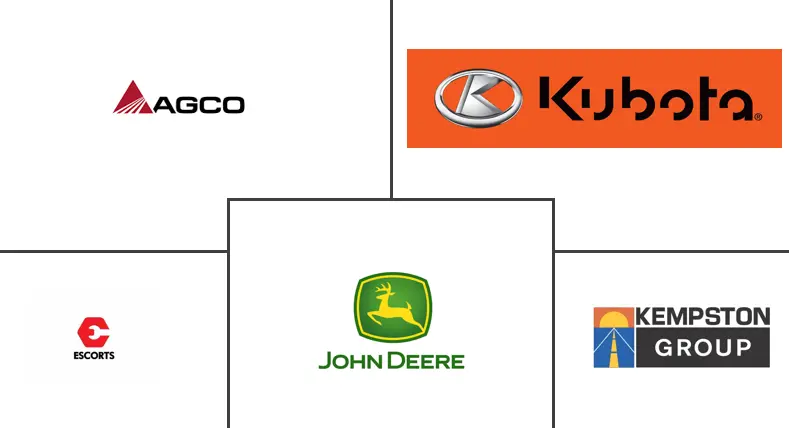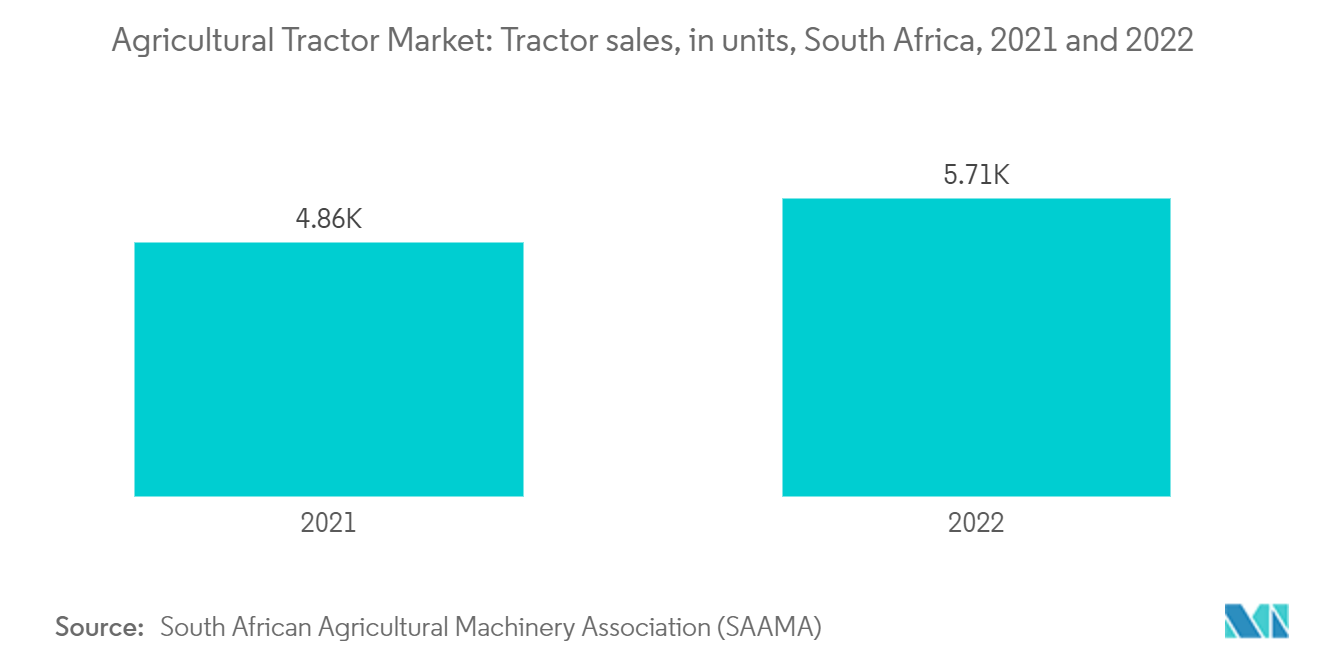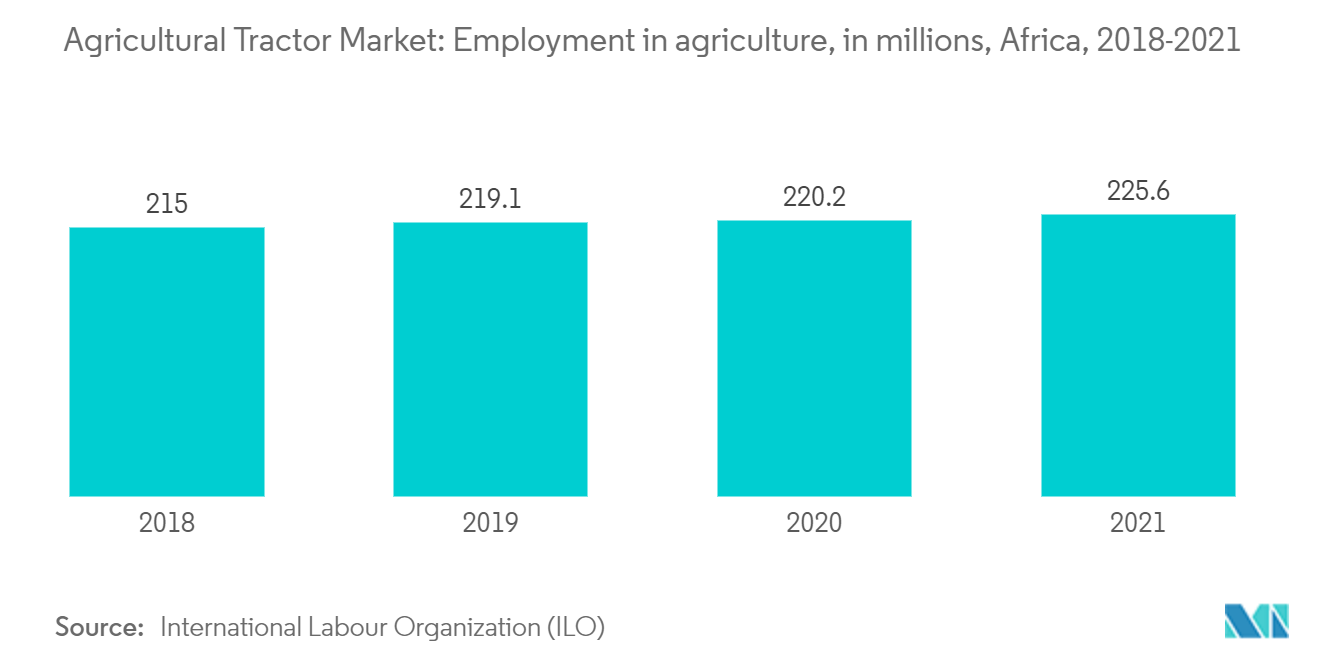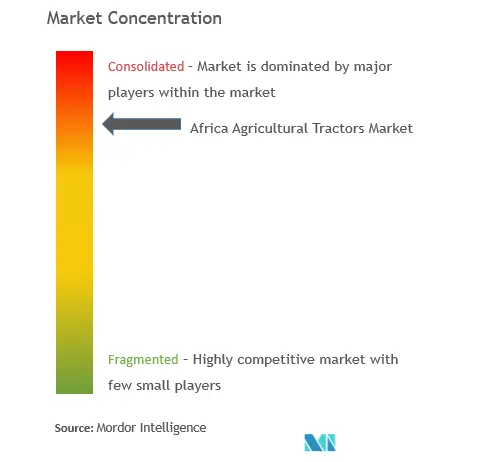Africa Agricultural Tractor Market Size

| Study Period | 2019 - 2029 |
| Base Year For Estimation | 2023 |
| Market Size (2024) | USD 1.18 Billion |
| Market Size (2029) | USD 1.58 Billion |
| CAGR (2024 - 2029) | 6.10 % |
| Market Concentration | High |
Major Players
*Disclaimer: Major Players sorted in no particular order |
Africa Agricultural Tractor Market Analysis
The Africa Agricultural Tractor Market size is estimated at USD 1.18 billion in 2024, and is expected to reach USD 1.58 billion by 2029, growing at a CAGR of 6.10% during the forecast period (2024-2029).
- Agriculture is critical to Africa's economic development, but it needs to function below its potential. Smallholder farmers make up more than 60% of the population in sub-Saharan Africa, and agriculture accounts for around 23% of the region's GDP. At the same time, the population is increasing on a large scale. As a result, there is an urgent need to raise crop yields in the coming decades to keep up with food demand in Africa. Therefore, mechanization in agriculture closes the yield gap by lowering harvest and post-harvest losses.
- As per the research survey conducted by the Agri Evolution Alliance, Africa holds great market potential for agricultural tractors. The increasing government support to develop the agricultural sector is expected to drive this sector.
- For instance, the Ghana government provides subsidized tractors to entrepreneurs who run 89 centers that rent out and service tractors. In major parts of Africa, tractor sales were affected due to uncertainty regarding crop yields and exchange rates. Additionally, issues with respect to land restitution and farmworkers' farm shares added to the farmers' uncertain conditions. Therefore, considering these factors, the market can witness growth in the coming years.
Africa Agricultural Tractor Market Trends
This section covers the major market trends shaping the Africa Agricultural Tractor Market according to our research experts:
Increasing Focus on Sustainable Agricultural Mechanization
- Agriculture plays a crucial role in the economic development of Africa. Despite Africa having the highest area of uncultivated arable land in the world, its productivity needs to catch up to other developing regions. Moreover, crop yields are only reaching 56% of the international average. Thus, there is a dire need to increase crop yields in the coming decades to keep pace with the food demand driven by population growth and rapid urbanization in Africa. Therefore, mechanization through tractors can, directly and indirectly, bridge the yield gap.
- Additionally, this region's tractor sales have witnessed a growing trend in the past few years. For instance, according to the South African Agricultural Machinery Association (SAAMA), in 2022, 5,705 units of tractors were sold, while 4,862 units were sold in August 2021 in South Africa. This showed an increase of 17.3% more than the previous year. Therefore, the increase in sales of tractors shows the trend of an increase in mechanization in Africa.
- According to the Food and Agriculture Organization of the United Nations (FAO), agricultural mechanization in Africa is still in its initial stages. The studies undertaken by FAO also revealed that the level of mechanization in the country is slowly moving from hand-driven technology to power sources.
- However, as stated in the sustainable development goals indicated in agenda 2063, the African Union Commission (AUC) and the Food and Agriculture Organization of the United Nations (FAO) view agricultural mechanization as an immediate indispensable action for attaining the Zero Hunger vision by 2025. Such initiatives toward sustainable agricultural mechanization will likely boost the market for agricultural tractors in the near future.

South Africa Dominates the Market
- South Africa is the largest market among African countries. The South African agricultural economy has witnessed a paradigm shift from food aid to domestic production in the form of the green revolution, which was first started by the World Food Program of the United Nations. South Africa now has major potential for the growth of the agriculture and agriculture machinery market, including tractors.
- In South Africa, there is a need for more farm workers due to increasing urbanization. This developed into a significant issue, driving up labor costs. As a result, farm equipment sales increased, helping the market expand. Additionally, increasing government subsidies for farm mechanization, accommodative financing, growth in the agricultural industry, and increased awareness of farm machine mechanization are driving the tractor market in the coming years.
- The tractor market in South Africa has been reinvigorating from the standstill brought to the market due to extremely dry weather conditions. Major global tractor industry players like Deere & Company and Mahindra & Mahindra, are planning to make South Africa the hub for manufacturing and exports, given the high potential that the farm equipment market holds in South Africa.
- The South African Crop Estimate Committee (SACEC) reported that farmers intend to increase the area plantings for summer grains and oilseeds in the next cropping season, thereby boosting the tractor market during the forecast period.

Africa Agricultural Tractor Industry Overview
The market is consolidated, with international players accounting for a higher market share. Deere & Company, Kempston Agri, and Kubota SA are the few key players in the African agricultural tractor market. Companies compete not only on equipment quality and promotion but also on strategic moves to attain larger market shares.
Africa Agricultural Tractor Market Leaders
-
AGCO Corporation
-
Kempston Agri
-
Kubota SA
-
Deere & Company
-
Escorts Group (Farmtrac)
*Disclaimer: Major Players sorted in no particular order

Africa Agricultural Tractor Market News
- June 2022: Agricultural vehicle supplier Argo Tractors South Africa inaugurated its new head office in South Africa. The new premise was built at the cost of USD 5. 88 million, hosts a 6000 square meter building, including office space, a 650 square meter showroom, a 100 square meter training facility, 2300 square meters dedicated to assembly, and 2000 square meters designated for spares.
- August 2022: Deere & Company invested in Hello Tractor, an ag-tech company based in Nairobi, Kenya. The company links tractor owners with smallholder farmers in Africa and Asia through a farm equipment-sharing app. It helps farmers to track and manage their fleets, schedule customers, and access financing options.
- November 2021: Mahindra South Africa (SA) launched a new range of tractors and farm equipment in the domestic market. The range included products from Sampo Rosenlew, of Finland, Mitsubishi Mahindra Agri Machinery of Japan, and Hisarlar and Erkunt equipment from Turkey. Together with the Mahindra EarthMaster Yellow Metal and Mahindra Powerol Generators, the company offered these products as a 'World of Solutions' to the South African farmer.
Africa Agricultural Tractor Market Report - Table of Contents
1. INTRODUCTION
1.1 Study Assumptions and Market Definition
1.2 Scope of the Study
2. RESEARCH METHODOLOGY
3. EXECUTIVE SUMMARY
4. MARKET DYNAMICS
4.1 Market Overview
4.2 Market Drivers
4.3 Market Restraints
4.4 Porter's Five Forces Analysis
4.4.1 Bargaining Power of Suppliers
4.4.2 Bargaining Power of Buyers
4.4.3 Threat of New Entrants
4.4.4 Threat of Substitute Products
4.4.5 Intensity of Competitive Rivalry
5. MARKET SEGMENTATION
5.1 Engine Power
5.1.1 Less than 35 HP
5.1.2 35 to 50 HP
5.1.3 51 to 75 HP
5.1.4 76 to 100 HP
5.1.5 Above 100 HP
5.2 Geography
5.2.1 South Africa
5.2.2 Kenya
5.2.3 Egypt
5.2.4 Rest of Africa
6. COMPETITIVE LANDSCAPE
6.1 Most Adopted Strategies
6.2 Market Share Analysis
6.3 Company Profiles
6.3.1 AGCO Corporation
6.3.2 CNH Industrial America LLC
6.3.3 Deere & Company
6.3.4 Argo Tractors SpA
6.3.5 Kempston Agri
6.3.6 Kubota SA
6.3.7 Escorts Ltd
6.3.8 Mahindra & Mahindra Limited
7. MARKET OPPORTUNITIES AND FUTURE TRENDS
Africa Agricultural Tractor Industry Segmentation
Agricultural tractors are types of machinery used in farming or other agriculture operations. The report defines the market in terms of end users that only procure tractors for agricultural production applications. The end users include farmers and institutional buyers operating in agriculture and allied production. The corporations in the tractor industry operate in the B2B and B2C formats. However, bulk buyers procuring tractors for retail sales are not considered in this market to eliminate any 'double-count' error in market estimations.
The African agricultural tractor market is segmented by engine power (less than 35 HP, 35 to 50 HP, 51 to 75 HP, 76 to 100 HP, and above 100 HP), geography (South Africa, Kenya, and the Rest of Africa).
The report offers the market size and forecasts in terms of volume in units and value in USD million for all the above segments.
| Engine Power | |
| Less than 35 HP | |
| 35 to 50 HP | |
| 51 to 75 HP | |
| 76 to 100 HP | |
| Above 100 HP |
| Geography | |
| South Africa | |
| Kenya | |
| Egypt | |
| Rest of Africa |
Africa Agricultural Tractor Market Research FAQs
How big is the Africa Agricultural Tractor Market?
The Africa Agricultural Tractor Market size is expected to reach USD 1.18 billion in 2024 and grow at a CAGR of 6.10% to reach USD 1.58 billion by 2029.
What is the current Africa Agricultural Tractor Market size?
In 2024, the Africa Agricultural Tractor Market size is expected to reach USD 1.18 billion.
Who are the key players in Africa Agricultural Tractor Market?
AGCO Corporation, Kempston Agri, Kubota SA, Deere & Company and Escorts Group (Farmtrac) are the major companies operating in the Africa Agricultural Tractor Market.
What years does this Africa Agricultural Tractor Market cover, and what was the market size in 2023?
In 2023, the Africa Agricultural Tractor Market size was estimated at USD 1.11 billion. The report covers the Africa Agricultural Tractor Market historical market size for years: 2019, 2020, 2021, 2022 and 2023. The report also forecasts the Africa Agricultural Tractor Market size for years: 2024, 2025, 2026, 2027, 2028 and 2029.
What are the major factors driving the Africa Agricultural Tractor Market?
The major factors driving the Africa Agricultural Tractor Market are a) Growing recognition of the role mechanization plays in improving farm productivity and efficiency b) Government and private initiatives to bring more land under cultivation can create a need for tractors
Africa Agricultural Tractor Industry Report
The Africa Agricultural Tractor Market is set for substantial growth, driven by the need for mechanization to enhance crop productivity and support regional economic development. This growth is crucial to meet the demands of a rapidly increasing population and to mitigate harvest losses. The pivotal role of tractors in this mechanization process, supported by robust government initiatives aimed at modernizing the agricultural sector, fosters strong market dynamics. This trend is particularly evident in South Africa, a dominant player in the market due to its shift from food reliance on imports to robust domestic production facilitated by significant investments in agricultural machinery, including prominent tractor brands in South Africa. The market is segmented by engine power and geographic regions, with detailed analyses provided for South Africa, Kenya, and the rest of Africa. Strategies to expand market footprint and enhance the availability of advanced farming machinery, along with efforts towards sustainable agricultural practices, continue to propel the market forward, aligning with goals to eradicate hunger and improve economic stability. For an in-depth market forecast and analysis, access a sample industry report PDF from Mordor Intelligence™ Industry Reports on the Africa Agricultural Tractor market.



